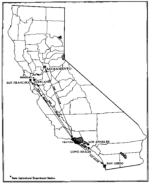Contact Us
University of California Cooperative Extension Ventura County
669 County Square Drive, Suite 100
Ventura, CA 93003
Phone: 805.645.1451
Fax: 805.645.1474
Office Hours:
Monday - Friday from 9 a.m. to 4 p.m.
The office will be closed for the following holidays:
The environmental characteristics of Ventura County and its soils
Content
SOIL SURVEY OF THE VENTURA AREA, CALIFORNIA
The Ventura Area is the southern part of Ventura County, which is in the southwestern part of California (fig.1). The Area surveyed consists of the privately owned land south of Los Padres National Forest, except for the islands of Anacapa and San Nicholas. The total extent of the Area is 548,874 acres, or about 858 square miles.
(Click on imager for larger fiew)
Soils Fig 1
The population of Ventura County, in January 1969, was 365,240. Oxnard, the largest incorporated city, had at that time a population of 66,890; Ventura, 51 ,470; the Thousand Oaks-Newbury Park area, 43,060; Camarillo, 18,630; Port Ilueneme, 18,000; and Santa Paula, 17,000.
Transportation facilities include a network of highways and freeways, railway service from Oxnard and Ventura and other major centers, bus service from most cities in the Area, and scheduled air service from Ventura County Airport. A number of small airports are available for private and industrial use. Local products are exported by sea from Port Hueneme, where a shipping wharf was first constructed in 1871. Submarine pipelines from the oilfields near Ventura make possible the offshore loading of oil tankers.
Mission San Buenaventura, established in 1782, was the first permanent settlement in this Area. The mission was on the site of the present-day city of Ventura, which still retains, officially, the name San Buenaventura. Ventura County was established on January 1, 1873. Prior to that date, the area was part of Santa Barbara County.
Farming and ranching, for the sustenance of the Mission, were major activities in the early days of the settlement. By the 1830’s there were 19 ranches in the county, covering altogether nearly half a million acres. Cattle, sheep, horses, and mules were raised. After 1848 ranching declined and the production of wheat, barley, corn, and other dry- farmed crops expanded. The first commercial citrus grove in the county was planted in 1874, near Santa Paula.
Irrigation on a large scale, introduced during the decade from 1880 to 1890, brought changes in agriculture. Walnuts and apricots were introduced, and for a time they were major crops. lima beans were grown extensively, also. Production of all three of these has declined in recent years. At present, the main money crops are lemons, oranges, and tomatoes. Other vegetables, strawberries, avocados, and fresh flowers are among the significant crops. Farming is still of major importance, although urban expansion has encroached on cropland.
Oil production began in 1866. A major field north of the city of Ventura was discovered in 1925, and the oil industry is now a leading source of income. Citrus packing and vegetable processing are among the other major industries. Sand and gravel works meet local demands for aggregates. Concrete pipe used in drainage systems and irrigation systems is manufactured locally. Light manufacturing and research industries have been moving into the Conejo Valley and the vicinity of Oxnard.
Navy installations at Port Hueneme and Point Mugu and an Air Force base at Camarillo have affected the economy of the county by accelerating the demand for housing and for commercial services.

